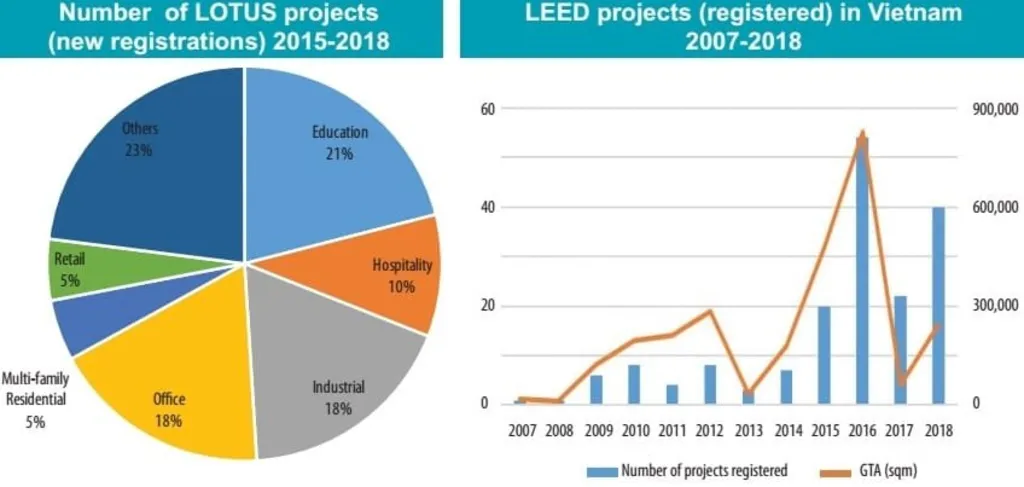Sustainable construction is becoming a priority in Vietnam. With over 300 green-certified buildings and a 20% annual growth rate since 2018, Vietnam is embracing environmentally friendly construction practices. Vietnam Green Building Certifications like LEED and LOTUS are helping developers build energy-efficient structures that benefit both the environment and their businesses.
The Role of Vietnam Green Building Certifications
Green building certifications set the standards for sustainable construction. These certifications ensure that buildings consume less energy, reduce waste, and promote healthier environments.

Vietnam has seen a rapid rise in green-certified buildings, with certifications such as:
LEED (Leadership in Energy and Environmental Design): A globally recognized certification that assesses energy efficiency, water savings, and CO2 reduction.
LOTUS: Vietnam’s own green certification system, tailored to the country’s climate and construction practices.
EDGE (Excellence in Design for Greater Efficiencies): A certification that focuses on resource efficiency and affordability.
The government aims for at least 20% of new construction projects to meet green standards by 2025, reflecting the country’s commitment to sustainable development.
Environmental Benefits of Vietnam Green Building Certifications
Green-certified buildings contribute significantly to reducing Vietnam’s carbon footprint. Studies show that they:
Reduce carbon emissions by 30-35% compared to traditional buildings.
Cut energy consumption by up to 25%.
Lower water usage by 40% through efficient plumbing and recycling systems.
These improvements align with Vietnam’s national climate goals and help developers future-proof their buildings against rising environmental regulations.
Financial Benefits for Developers
Green certifications do more than just protect the environment—they also provide strong financial returns for developers. According to industry reports:
Green-certified properties experience a 7-10% increase in value.
Developers report 5-8% higher rental income from green-certified spaces.
Certified buildings reduce operational costs by 15-20% over their lifespan.
These financial incentives make sustainable construction an attractive choice for developers looking to maximize long-term profits.
Growing Demand for Green-Certified Buildings
A shift in tenant preferences is driving the demand for sustainable spaces:
According to Savills Vietnam, 65% of tenants prefer leasing green-certified offices due to better air quality and lower operational costs.
Employees working in green-certified buildings report higher productivity and well-being due to improved air circulation and natural lighting.
With rising consumer awareness, developers who prioritize sustainability will have a competitive edge in attracting premium tenants and investors.
Challenges and Future Outlook for Vietnam Green Building Certifications
Despite the benefits, some challenges remain:
Higher upfront costs: Sustainable construction often requires advanced materials and technology, increasing initial investment.
Limited awareness: Some developers still hesitate to adopt green practices due to a lack of understanding.
Regulatory compliance: While Vietnam is setting ambitious targets, stronger policy enforcement is needed to ensure widespread adoption.
However, as financial benefits become clearer and regulations tighten, green certifications will likely become the standard for new construction projects in Vietnam.
Vietnam’s green building movement is gaining momentum. Green certifications like LEED, LOTUS, and EDGE are helping developers build more sustainable, cost-efficient, and desirable properties. With rising demand, government support, and proven financial benefits, investing in green-certified buildings is no longer just an ethical choice—it’s a smart business strategy. By adopting Vietnam Green Building Certifications and practices today, developers can future-proof their investments, reduce operational costs, and contribute to a more sustainable Vietnam.






